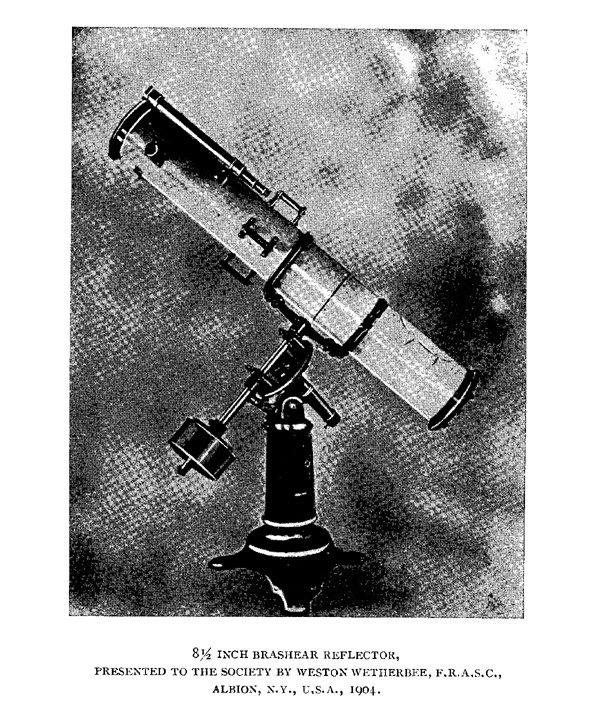
Equatorially mounted reflector with 8.5-inch primary mirror by RASC member John A. Brashear. This was donated to the Society by Weston Wetherbee, FRASC, in 1904. It was a considerable gift at the time. Its present whereabouts are unknown (unnumbered plate from The Royal Astronomical Society of Canada Selected Papers and Proceedings 1904).
Many astronomical institutions, such as observatories, or astronomical associations, possess collections of astronomical artifacts. As implied in the podcast, the majority of these entities didn't intentionally set out to form museums of astronomy. The simple act of acquiring up-to-date sceintific apparatus, and retaining it, means that in time the institution's equipment transitions from current, to vintage, to antique. Age does not rob these objects of their scientific ultility, but it may change it. They can still be used to inform modern practitioners about how valuable data was acquired in the past, they can lead lay viewers into considerations of the non-static nature of science, and with a little imagination they can be put to valuable data acquisition now. Antique apparatus, and old logbooks, are carriers of narrative—they can be the scaffolding for sometimes surprising stories of science.
A few sources for material mentioned in the podcast are given below, for those who'd like to explore the material further.
- King Charles (1338-1380) "le sage" of France's inventories listing his scientific equipment in the context of a "treasury", are published in: Inventaire du mobilier de Charles V, roi de France. ed. Jules Labarte (Paris: Imprimerie nationale, 1879), pp. 224, 230, 242, 246, 261, 290, 298, 325
- Cardinal Nicholas of Cusa's (1401-1464) surviving astronomical equipment is illustrated and discussed in: J. Hartmann, Die astronomischen Instrumente des Kardinals Nikolaus Cusanus (Berlin: Weidmannsche Buchhandlung, 1919)
- astronomical instruments in Kuntskammern, and their association with book collections, is partly treated in; J.H. Leopold, "Collecting Instruments in Protestant Europe Before 1800", Journal of the History of Collections 7, 2 (1995 December), 151-157; and illustrated by a panel from the Studiolo from the Ducal Palace in Gubbio, New York, Metropolitan Museum of Art, acc. no. 39.153, ca. 1478-1482; as well as in a portrait of Ptolemy, from a copy of his Geography, Venice, Biblioteca Nazionale Marciana, Cod. Gr. Z. 388 (=333), f. 6v, ca. 1453 (the model for the figure of Ptolemy in this illumination may be the notable patron of astronomy, Cardinal Bessarion [1403-1472])
- the history of the Royal Society of London from which the quote comes is: Thomas Sprat, The History of the Royal-Society of London for the Improving of Natural Knowledge (London: J. Martyn & J. Allestry, 1667)
Finally, a few of the scientific artifacts missing from the RASC's own treasury, besides the Brashear reflector illustraed above, are:
- one or more Rowland diffraction gratings (an example of a Rowland diffraction grating belonging to another institution can be found here)
- a copy of Beer and Mädler’s Mappa Selenographica of 1836 (another copy can be explored here)
Perhaps one day these will return to the Society...
—R.A. Rosenfeld
A transcript of this podcast is available.
| Attachment | Size |
|---|---|
| 190.39 KB |
